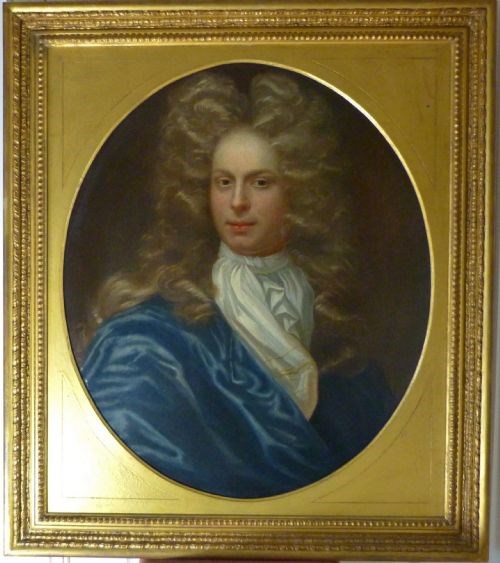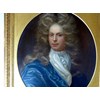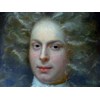Portrait of James Radclyffe, 3rd Earl of Derwentwater; Studio or Circle of John Closterman.
By Roy Precious From United Kingdom
| Shipping Destination | Single Item | Additional Items |
|---|
The estimated delivery time is (Mon-Fri) until the seller will dispatch the item. Actual delivery time will depend on your delivery location
Oval oil on canvas mounted in later giltwood frame.
JAMES RADCLYFFE, 3rd Earl of Derwentwater (26 June 1689 – 24 February 1716) was an English Jacobite, executed for treason. His death is remembered in an English traditional ballad, "Lord Allenwater".
He was the son of Edward Radclyffe, 2nd Earl of Derwentwater and Lady Mary Tudor, the natural daughter of Charles II by Moll Davis. He was brought up at the exiled Court of St Germain as a companion to the young prince, James Francis Edward Stuart (the 'Old Pretender' after his father James II died), and remained there at the wish of Queen Mary of Modena, until his father's death in 1705. He succeeded to the family titles and estates in Northumberland on the death of his father in 1705.
He spent the next two years at Dilston Hall, Northumberland, (see image 5), the mansion built by his grandfather on the site of the ancestral home from 1521; he began the construction of a grand mansion to replace the old Hall, a task that was never completed.
He joined the conspiracy of 1715; he was suspected by the government, and on the eve of the insurrection the secretary of state, Stanhope, signed a warrant for his arrest. A messenger was sent to Durham to secure him, but Radclyffe went into hiding. He heard that Thomas Forster had raised the standard of the Pretender, and Radclyffe joined him at Greenrigg, on 6 October 1715, at the head of a company of gentlemen and armed servants from Dilston Hall.
The Jacobite army was defeated at the Battle of Preston. Radclyffe was escorted with the other prisoners to London by General Henry Lumley, and lodged in the Devereux tower of the Tower of London. At his trial Derwentwater pleaded guilty, urging in extenuation his inexperience, and his advice to those who were about him to throw themselves upon the royal clemency. He was attainted, and condemned to death.
Efforts were made to procure his pardon. Petitions were brought before both Houses of Parliament, and an address was carried from the Upper House to the throne on 22 February, praying that his Majesty George I of the United Kingdom would reprieve him. The Countess, accompanied by her sister, their maternal aunt, the Duchess of Richmond, the Duchess of Cleveland, and other ladies, was introduced by the Duke of Richmond into the king's bedchamber, where the countess, in French, asked for His Majesty's mercy...to no avail.
Derwentwater was beheaded on Tower Hill on 24 February 1716. On the scaffold he expressed regret at having pleaded guilty, and declared his devotion to his Roman Catholic religion and to 'King' James III.
He had married Anna Maria Webb in 1712. She was the eldest daughter of Sir John Webb, 3rd baronet, of Odstock, Wiltshire, by Barbara, daughter and coheiress of John Belasyse, 1st Baron Belasyse.
Their only son John (1713–1731) succeeded. They also had a daughter, Lady Mary Radclyffe (1714–31 January 1760), who married Robert James Petre, 8th Baron Petre.
Lady Derwentwater and her children fled to Brussels in 1721, and she died there of smallpox in 1723.
JOHN CLOSTERMAN (1660-1711) was born in Osnabruck, the son of an artist. His early training was from his father, but in 1679 he moved to Paris where for two years he studied under the portraitist Francois de Troy.
In 1681 Closterman came to England. By 1683 he had developed a flourishing practice; he was adept at baroque poses still with a slightly French influence, with rather flashily painted drapery
SIZE: 36.5 inches x 32 inches inc. frame.
PROVENANCE: Yorkshire Private Collection for c.60 years. VERSO: old label with details of the Earl, signed 'Austin Pickering, May 1948'.

-
Roy Precious
United Kingdom
We specialise in portraits from the 16th to the early 20th century, we also stock some 17th and 18th century ship paintings, furniture of the 17th and 18th centuries, and other artefacts dating from 200 B.C. to the 20th century.We have sold to many important collections including The Historic Royal Palaces collection and The Yale Center for British Art. Viewing is by appointment, or an arrangement can be made for the item to be brought to your home for inspection.






